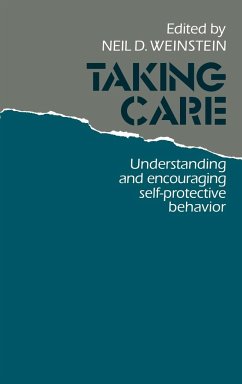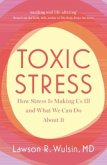- Gebundenes Buch
- Merkliste
- Auf die Merkliste
- Bewerten Bewerten
- Teilen
- Produkt teilen
- Produkterinnerung
- Produkterinnerung
Taking Care examines the reasons why people take precautions - and the reasons why they do not.
Andere Kunden interessierten sich auch für
![El Arte de Cuidarte / The Art of Taking Care of Yourself El Arte de Cuidarte / The Art of Taking Care of Yourself]() Gio ZararriEl Arte de Cuidarte / The Art of Taking Care of Yourself15,99 €
Gio ZararriEl Arte de Cuidarte / The Art of Taking Care of Yourself15,99 €![Why Has Nobody Told Me This Before? Why Has Nobody Told Me This Before?]() Julie SmithWhy Has Nobody Told Me This Before?14,99 €
Julie SmithWhy Has Nobody Told Me This Before?14,99 €![Why Has Nobody Told Me This Before? Why Has Nobody Told Me This Before?]() Julie SmithWhy Has Nobody Told Me This Before?14,99 €
Julie SmithWhy Has Nobody Told Me This Before?14,99 €![Rewire Rewire]() Nicole VignolaRewire13,99 €
Nicole VignolaRewire13,99 €![Toxic Stress Toxic Stress]() Lawson R. WulsinToxic Stress12,99 €
Lawson R. WulsinToxic Stress12,99 €![Switch Craft Switch Craft]() Elaine FoxSwitch Craft23,74 €
Elaine FoxSwitch Craft23,74 €![Irrationally Yours Irrationally Yours]() Dan ArielyIrrationally Yours14,99 €
Dan ArielyIrrationally Yours14,99 €-
-
-
Taking Care examines the reasons why people take precautions - and the reasons why they do not.
Hinweis: Dieser Artikel kann nur an eine deutsche Lieferadresse ausgeliefert werden.
Hinweis: Dieser Artikel kann nur an eine deutsche Lieferadresse ausgeliefert werden.
Produktdetails
- Produktdetails
- Verlag: Cambridge University Press
- Seitenzahl: 364
- Erscheinungstermin: 25. Oktober 2007
- Englisch
- Abmessung: 235mm x 157mm x 26mm
- Gewicht: 741g
- ISBN-13: 9780521324359
- ISBN-10: 0521324351
- Artikelnr.: 23399953
- Herstellerkennzeichnung
- Libri GmbH
- Europaallee 1
- 36244 Bad Hersfeld
- gpsr@libri.de
- Verlag: Cambridge University Press
- Seitenzahl: 364
- Erscheinungstermin: 25. Oktober 2007
- Englisch
- Abmessung: 235mm x 157mm x 26mm
- Gewicht: 741g
- ISBN-13: 9780521324359
- ISBN-10: 0521324351
- Artikelnr.: 23399953
- Herstellerkennzeichnung
- Libri GmbH
- Europaallee 1
- 36244 Bad Hersfeld
- gpsr@libri.de
List of contributors; Acknowledgements; Introduction: studying
self-protective behaviour Neil D. Weinstein; Part I. Theoretical
Perspectives: 1. Behavioural decision theory perspectives on protective
behaviour Paul Slovic, Baruch Fischhoff and Sarah Lichtenstein; 2. Social
learning theory and preventive behaviour Alfred McAlister; 3. The role of
emotion and psychological defense in self-protective behaviour James R.
Averill; 4. The diffusion of innovations perspective Everett M. Rogers; 5.
Cultural influences on prevention and the emergence of a new health
consciousness Robert Crawford; Part II. Research and Prevention Programs
for Specific Hazards; Section 1. Health: 6. Why people take precautions
against health risks Paul D. Cleary; 7. Community studies of smoking
cessation Surgeon General's Report; 8. Preventing adolescent smoking Kevin
D. McCaul and Russell E. Glasgow; Section 2. Natural Hazards: 9. Natural
hazards and precautionary behaviour Dennis S. Mileti and John H. Sorensen;
10. Programs that encourage the adoption of precautions against natural
hazards: review and evaluation John H. Sorensen and Dennis S. Mileti;
Section 3. Crime: 11. Why people take precautions against crime: a review
of the literature on individual and collective responses to crime Stephanie
W. Greenberg; 12. Promoting citizen involvement in crime prevention and
control Fred Heinzelmann; Section 4. Inquiry, Safety, and Occupational
Settings: 13. Injury prevention: limits to self-protective behaviour Leon
S. Robertson; 14. Perspectives on protective behaviours and work place
hazards Alexander Cohen; Part III. Conclusion: 15. Cross-hazard
consistencies: conclusions about self-protective behaviour Neil D.
Weinstein; Index.
self-protective behaviour Neil D. Weinstein; Part I. Theoretical
Perspectives: 1. Behavioural decision theory perspectives on protective
behaviour Paul Slovic, Baruch Fischhoff and Sarah Lichtenstein; 2. Social
learning theory and preventive behaviour Alfred McAlister; 3. The role of
emotion and psychological defense in self-protective behaviour James R.
Averill; 4. The diffusion of innovations perspective Everett M. Rogers; 5.
Cultural influences on prevention and the emergence of a new health
consciousness Robert Crawford; Part II. Research and Prevention Programs
for Specific Hazards; Section 1. Health: 6. Why people take precautions
against health risks Paul D. Cleary; 7. Community studies of smoking
cessation Surgeon General's Report; 8. Preventing adolescent smoking Kevin
D. McCaul and Russell E. Glasgow; Section 2. Natural Hazards: 9. Natural
hazards and precautionary behaviour Dennis S. Mileti and John H. Sorensen;
10. Programs that encourage the adoption of precautions against natural
hazards: review and evaluation John H. Sorensen and Dennis S. Mileti;
Section 3. Crime: 11. Why people take precautions against crime: a review
of the literature on individual and collective responses to crime Stephanie
W. Greenberg; 12. Promoting citizen involvement in crime prevention and
control Fred Heinzelmann; Section 4. Inquiry, Safety, and Occupational
Settings: 13. Injury prevention: limits to self-protective behaviour Leon
S. Robertson; 14. Perspectives on protective behaviours and work place
hazards Alexander Cohen; Part III. Conclusion: 15. Cross-hazard
consistencies: conclusions about self-protective behaviour Neil D.
Weinstein; Index.
List of contributors; Acknowledgements; Introduction: studying
self-protective behaviour Neil D. Weinstein; Part I. Theoretical
Perspectives: 1. Behavioural decision theory perspectives on protective
behaviour Paul Slovic, Baruch Fischhoff and Sarah Lichtenstein; 2. Social
learning theory and preventive behaviour Alfred McAlister; 3. The role of
emotion and psychological defense in self-protective behaviour James R.
Averill; 4. The diffusion of innovations perspective Everett M. Rogers; 5.
Cultural influences on prevention and the emergence of a new health
consciousness Robert Crawford; Part II. Research and Prevention Programs
for Specific Hazards; Section 1. Health: 6. Why people take precautions
against health risks Paul D. Cleary; 7. Community studies of smoking
cessation Surgeon General's Report; 8. Preventing adolescent smoking Kevin
D. McCaul and Russell E. Glasgow; Section 2. Natural Hazards: 9. Natural
hazards and precautionary behaviour Dennis S. Mileti and John H. Sorensen;
10. Programs that encourage the adoption of precautions against natural
hazards: review and evaluation John H. Sorensen and Dennis S. Mileti;
Section 3. Crime: 11. Why people take precautions against crime: a review
of the literature on individual and collective responses to crime Stephanie
W. Greenberg; 12. Promoting citizen involvement in crime prevention and
control Fred Heinzelmann; Section 4. Inquiry, Safety, and Occupational
Settings: 13. Injury prevention: limits to self-protective behaviour Leon
S. Robertson; 14. Perspectives on protective behaviours and work place
hazards Alexander Cohen; Part III. Conclusion: 15. Cross-hazard
consistencies: conclusions about self-protective behaviour Neil D.
Weinstein; Index.
self-protective behaviour Neil D. Weinstein; Part I. Theoretical
Perspectives: 1. Behavioural decision theory perspectives on protective
behaviour Paul Slovic, Baruch Fischhoff and Sarah Lichtenstein; 2. Social
learning theory and preventive behaviour Alfred McAlister; 3. The role of
emotion and psychological defense in self-protective behaviour James R.
Averill; 4. The diffusion of innovations perspective Everett M. Rogers; 5.
Cultural influences on prevention and the emergence of a new health
consciousness Robert Crawford; Part II. Research and Prevention Programs
for Specific Hazards; Section 1. Health: 6. Why people take precautions
against health risks Paul D. Cleary; 7. Community studies of smoking
cessation Surgeon General's Report; 8. Preventing adolescent smoking Kevin
D. McCaul and Russell E. Glasgow; Section 2. Natural Hazards: 9. Natural
hazards and precautionary behaviour Dennis S. Mileti and John H. Sorensen;
10. Programs that encourage the adoption of precautions against natural
hazards: review and evaluation John H. Sorensen and Dennis S. Mileti;
Section 3. Crime: 11. Why people take precautions against crime: a review
of the literature on individual and collective responses to crime Stephanie
W. Greenberg; 12. Promoting citizen involvement in crime prevention and
control Fred Heinzelmann; Section 4. Inquiry, Safety, and Occupational
Settings: 13. Injury prevention: limits to self-protective behaviour Leon
S. Robertson; 14. Perspectives on protective behaviours and work place
hazards Alexander Cohen; Part III. Conclusion: 15. Cross-hazard
consistencies: conclusions about self-protective behaviour Neil D.
Weinstein; Index.









